A bird with a prehistoric appearance
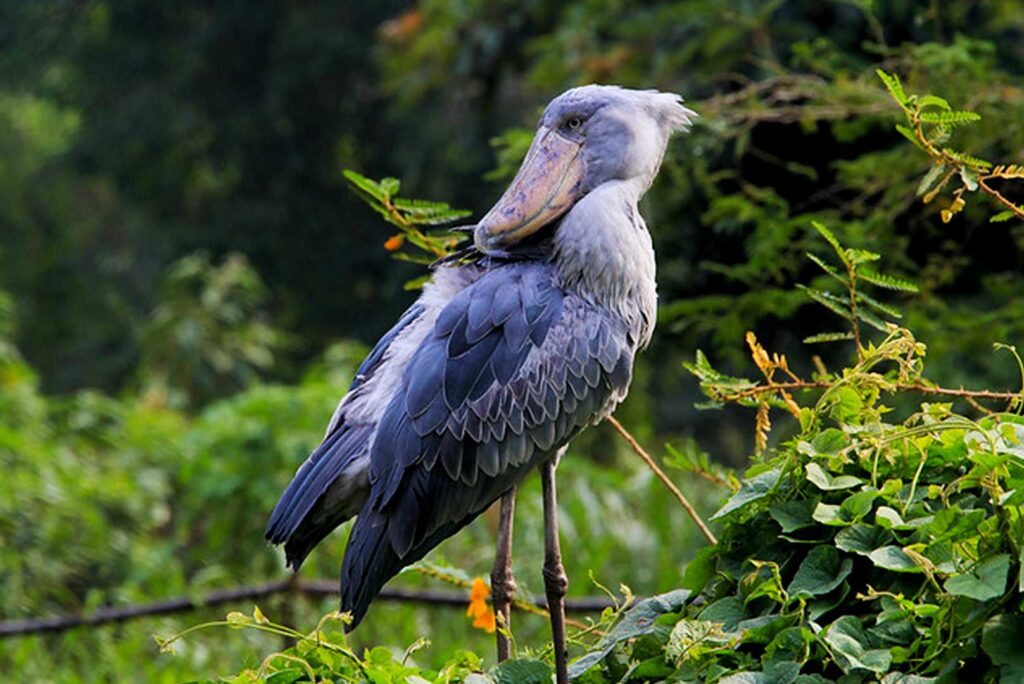
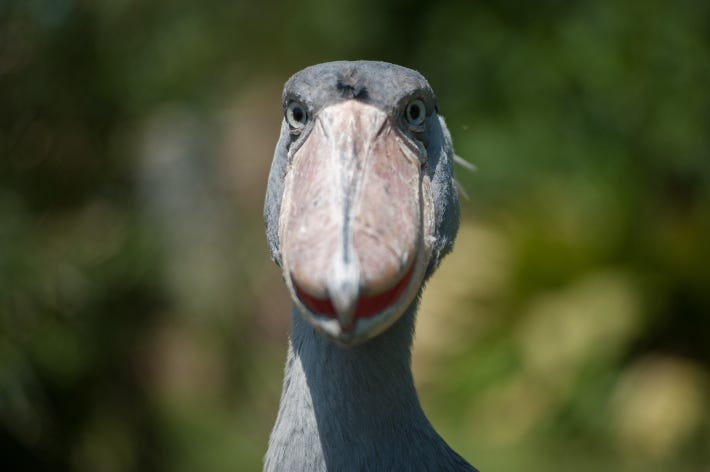

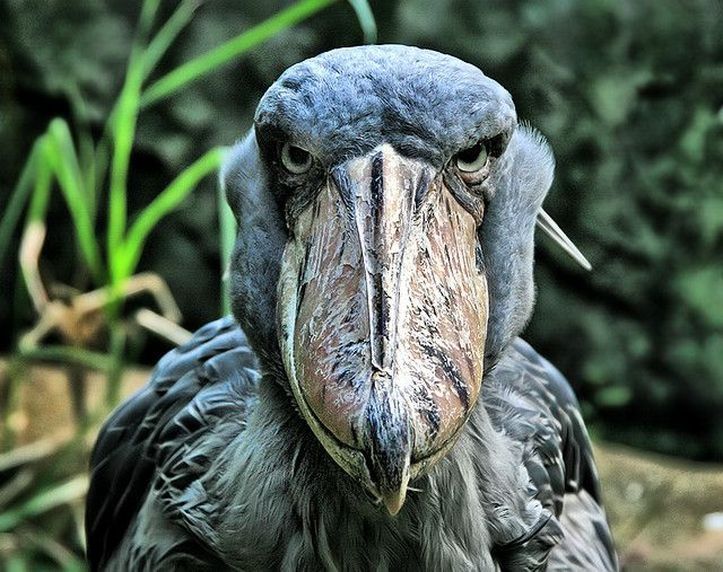
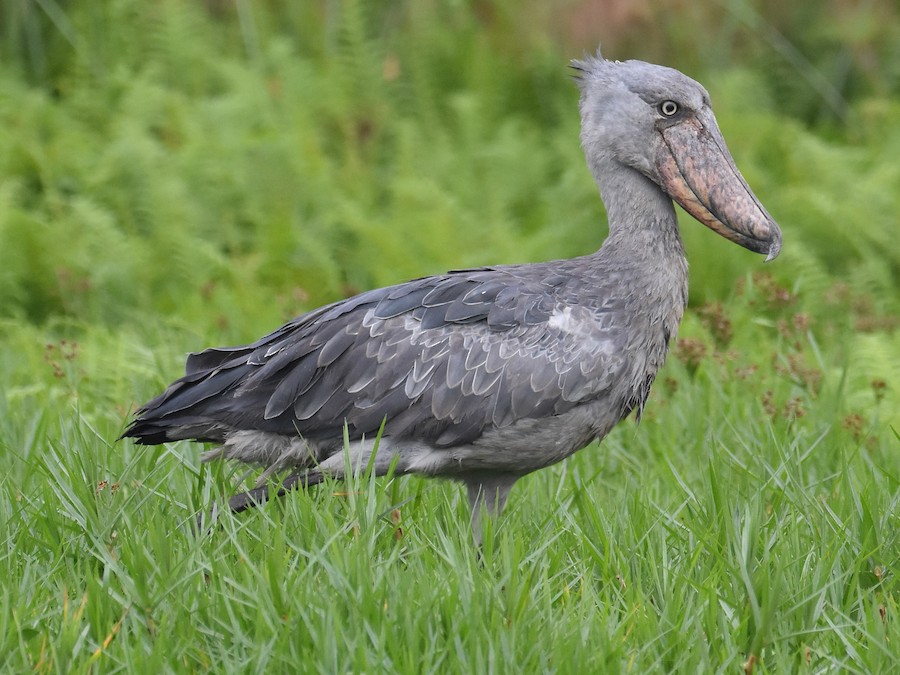
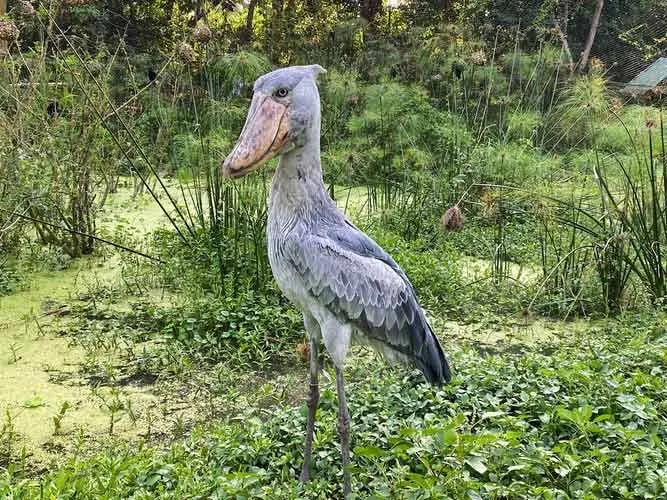
The Shoebill is a large African bird that lives in wetlands, far from human settlements. Its characteristic large, massive beak resembling a wooden shoe makes its image quite menacing. It happens that people are afraid of him, although he is a gentle bird that can greet a person beautifully by tilting his head or responding in this way to a tilt of his head by a man. Although it looks like a prehistoric creature and is familiar with the phenomenon of Cainism (behavior whereby stronger siblings eliminate weaker individuals to remove food competition), it is essentially a lovable bird.
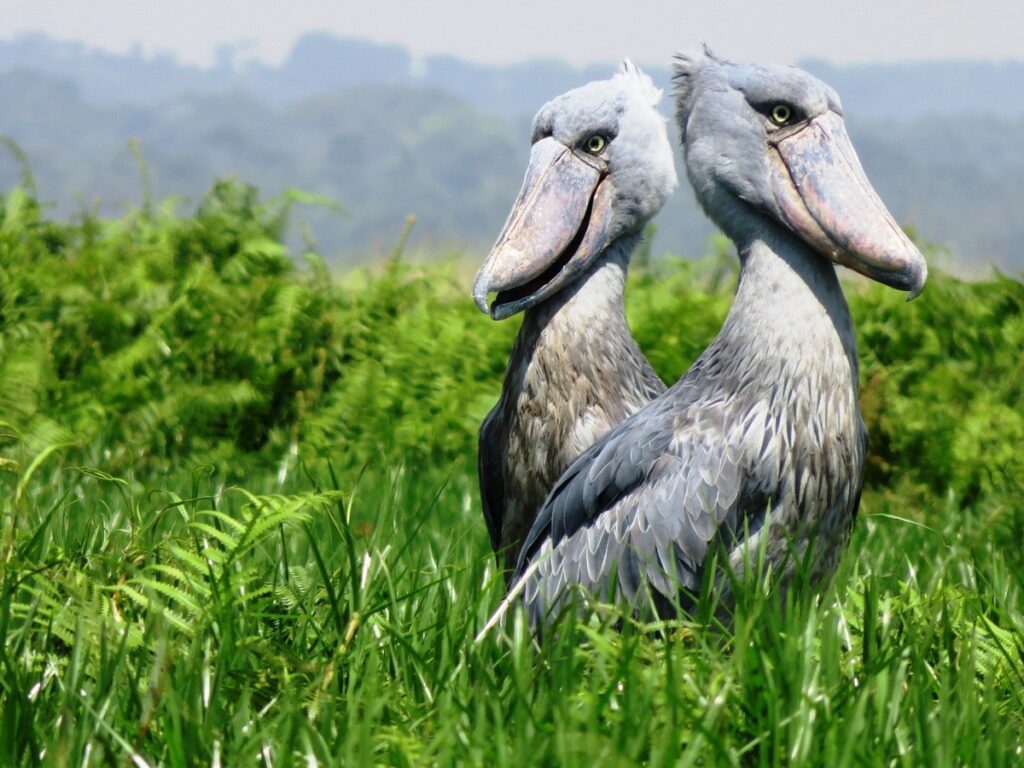
The shoebill (Balaeniceps rex) is a species of bird in the shoebill family (Balaenicipitidae). He is the only representative of this family.
Balaeniceps rex means “whale-head king,” evidently a reference to its bill shape resembling the head of a baleen whale (as well as a shoe). Other names for the shoebill include the boat-bill, bog-bird, lesser lechwe-eater (referring to the shoebill’s alleged taste for lechwe, or aquatic antelope), and Abu markub, or “father of a slipper” in Arabic.
The Shoebill is a bird with a very distinctive appearance.
The most characteristic part of its body is its thick, wide beak, adapted to searching for food in the silt. The beak resembles a wooden shoe. It has an elongated, wide shape and a hooked end, making it easier to catch slippery food. The color of the beak is yellowish with fine darker spots.
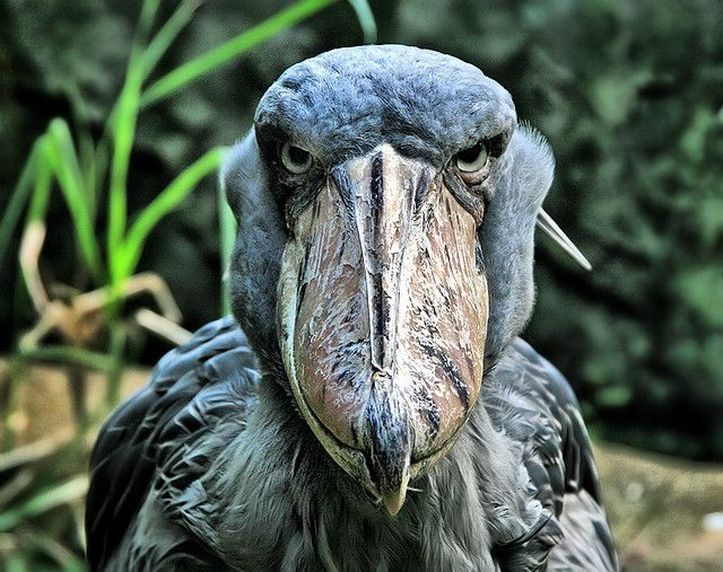
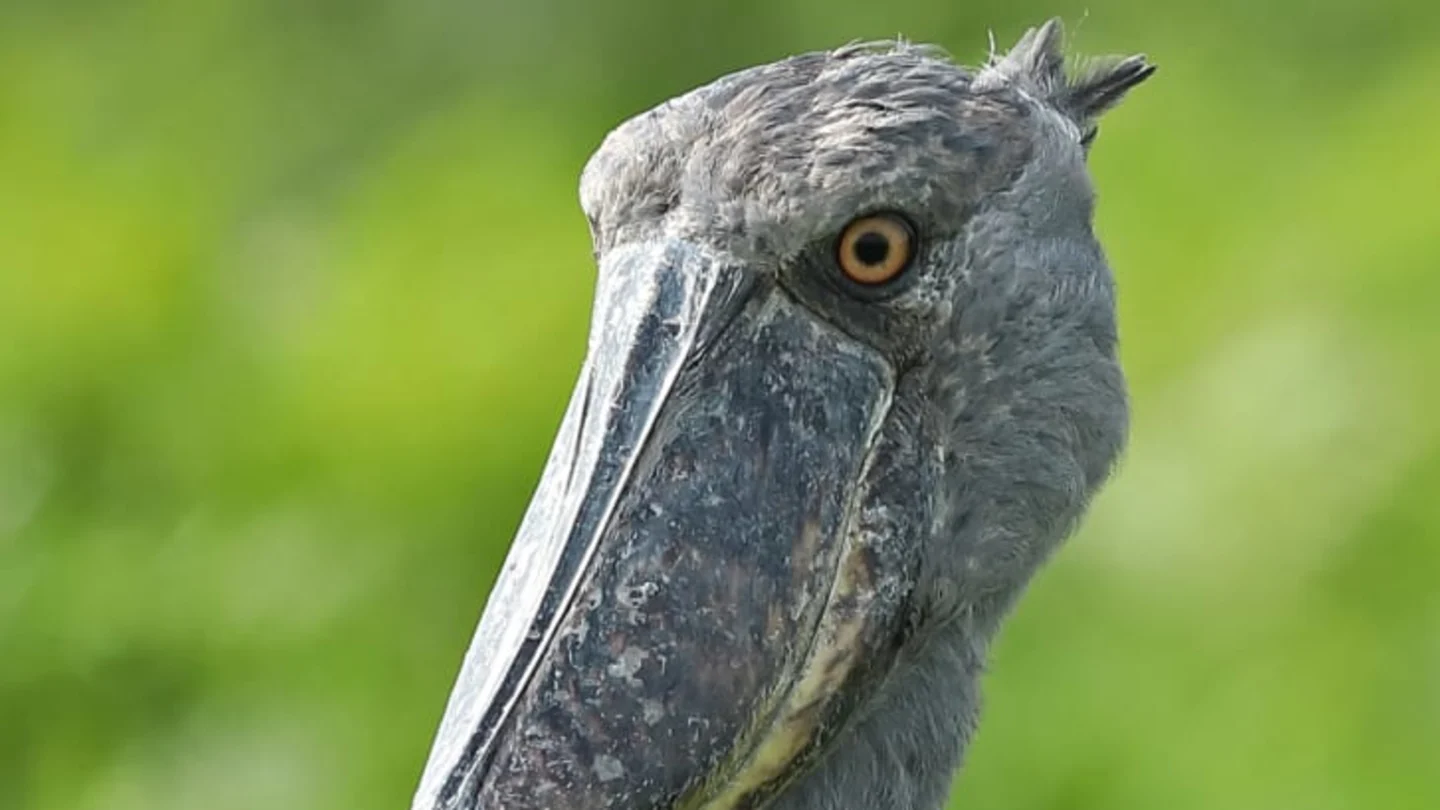

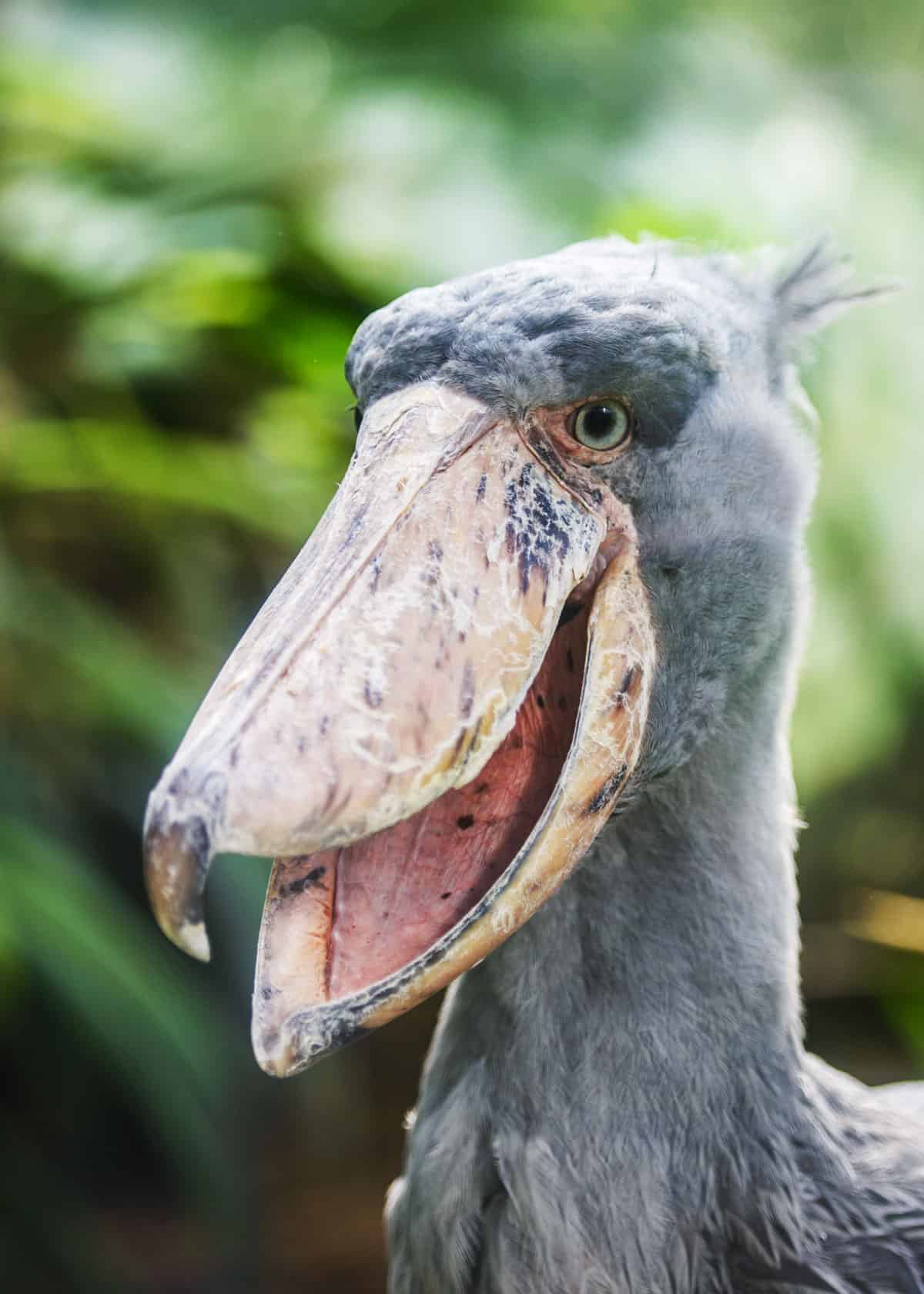
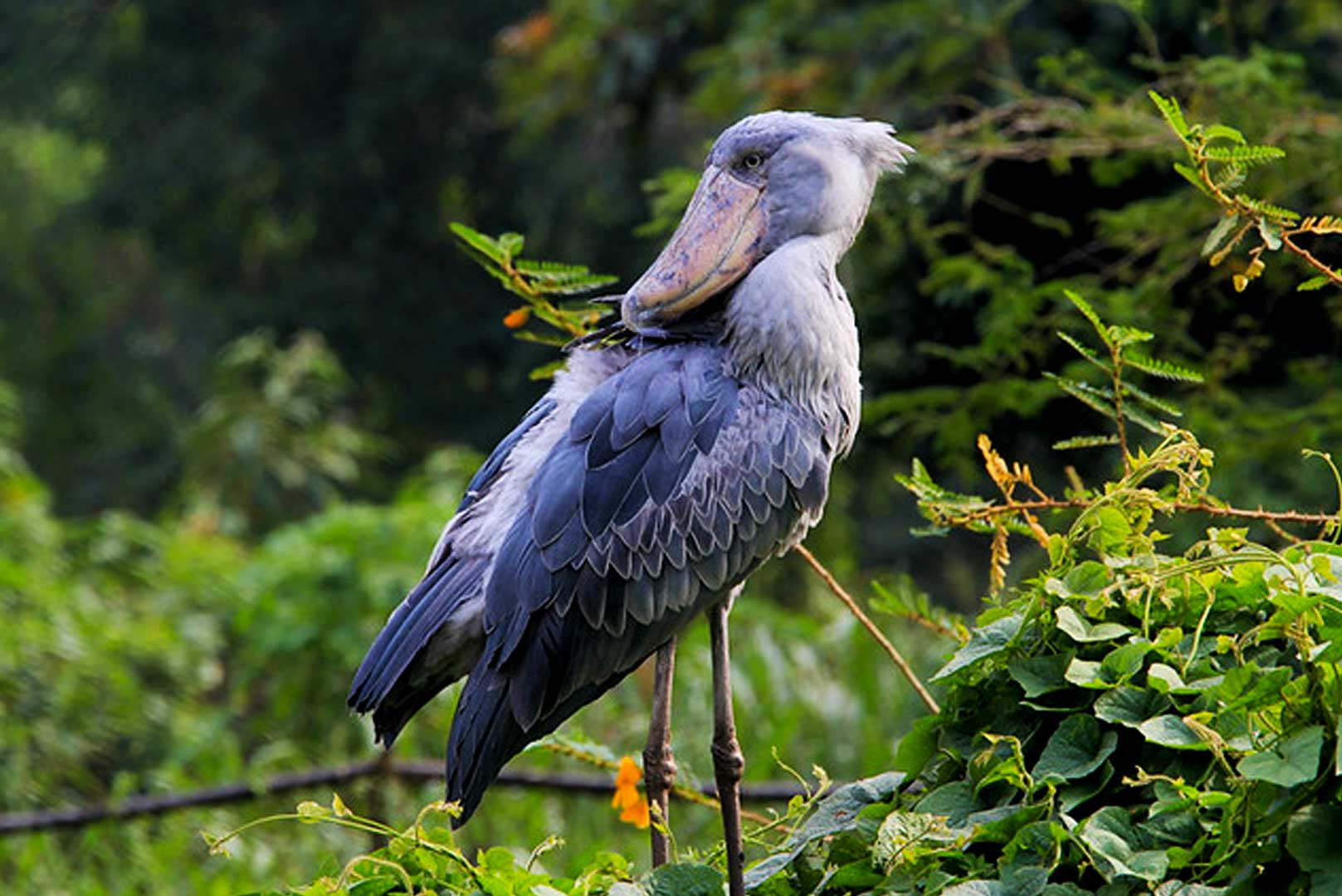
The eyes of these birds are relatively large, and shifted forward, which gives shoebills better three-dimensional vision. The eyes are yellowish or gray-white in color.
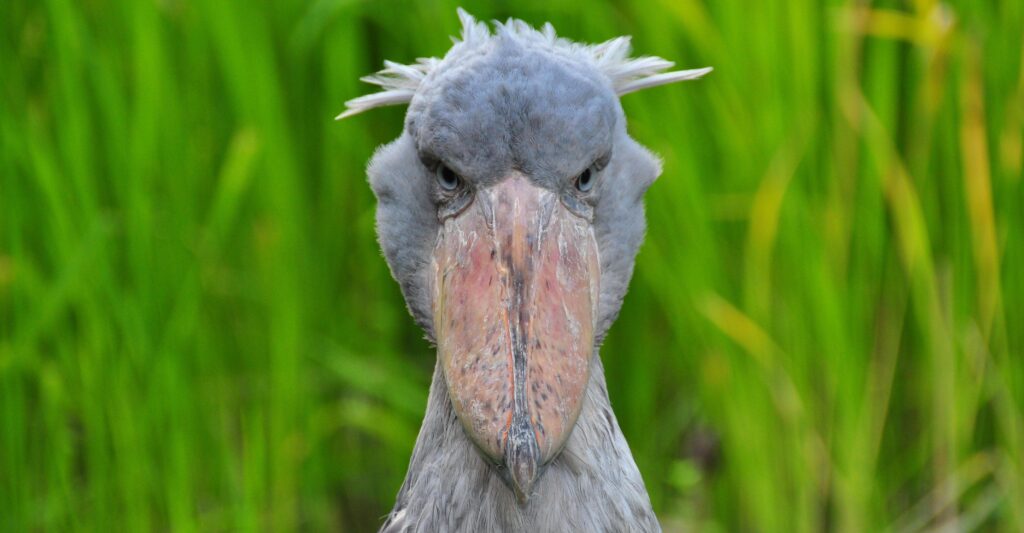
The plumage of the birds is bluish-gray with a greenish sheen.
The back and neck are covered with blue-gray feathers with a greenish sheen, while the underside of the body is usually lighter in color. The head is generally darker than the rest of the body and has a tuft of spiky feathers at the back.
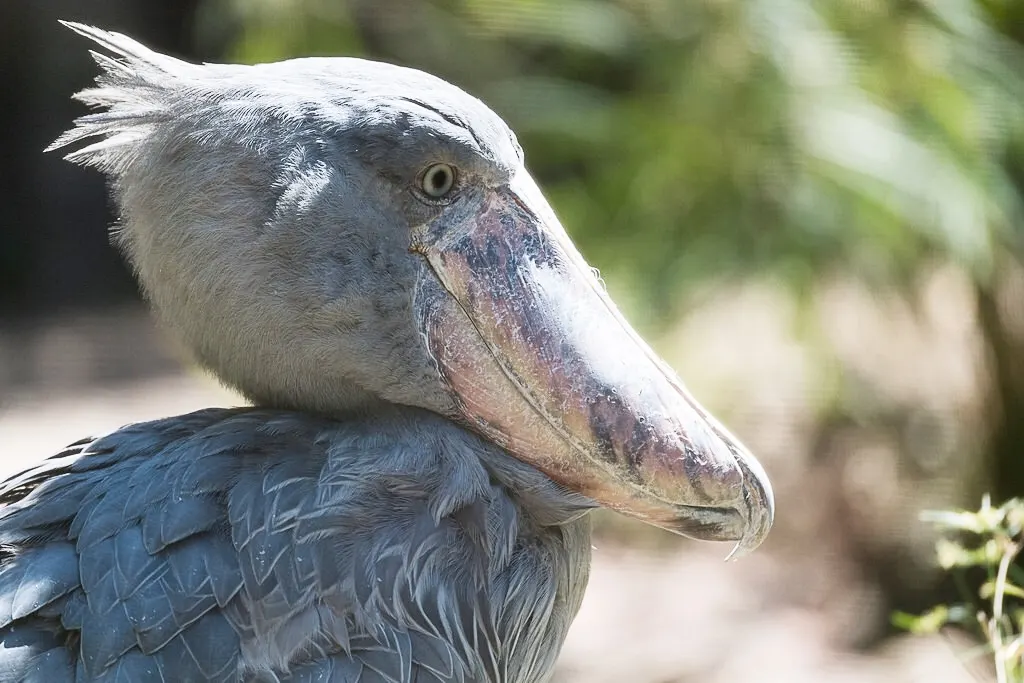
This species was first scientifically described in 1850 by the English ornithologist John Gould. Initially, shoebills were classified as storks (Ciconiiformes). However, based on anatomical similarities, it was found that the shoebills are closer to the pelecanids (Pelecanidae) – DNA studies confirmed that they belong to the order of pelecanids (Pelecaniformes).
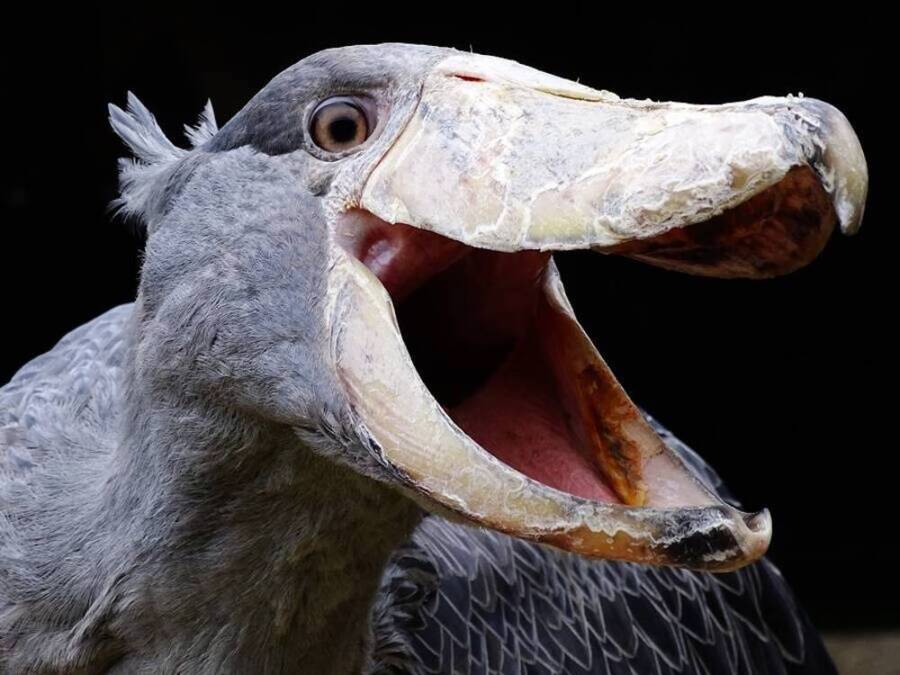
Drawings of the Shoebill are found in Egyptian tombs and are dated around 3500 before Common Era. It is forbidden to hunt these birds among some African tribes. They are also the subject of superstition – one of them says that the mere mention of the name of this bird during a boat trip can cause a storm.
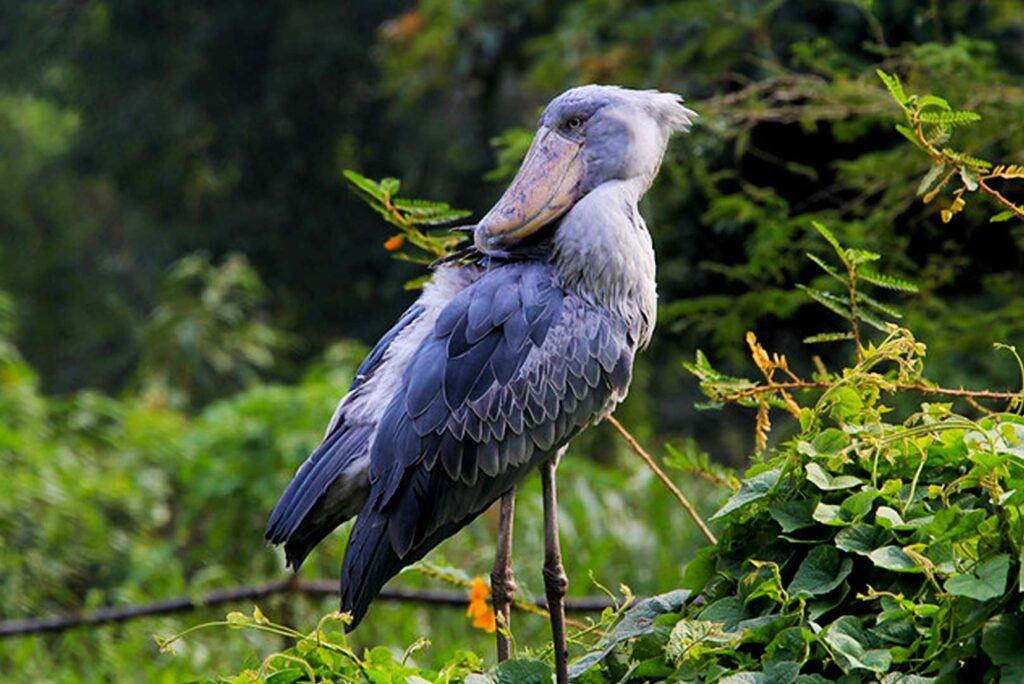



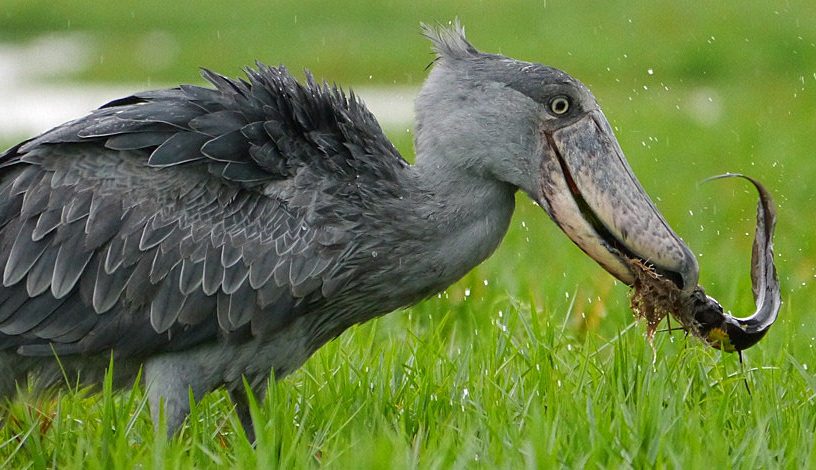
The shoebill resembles a stork.
Its massive body and its legs are long and thin. The neck is slender and while it seems long, it is shorter than that of other wading birds (egret, crane).
Shoebills are endemic to Africa and live mainly in the eastern and tropical zones of Africa. They are found from South Sudan and southwestern Ethiopia through Uganda to the southeast Congo and northern Zambia. The highest density of shoebills is in Sudan and Zambia. Outside the breeding season, these birds can also be found in the Central African Republic.
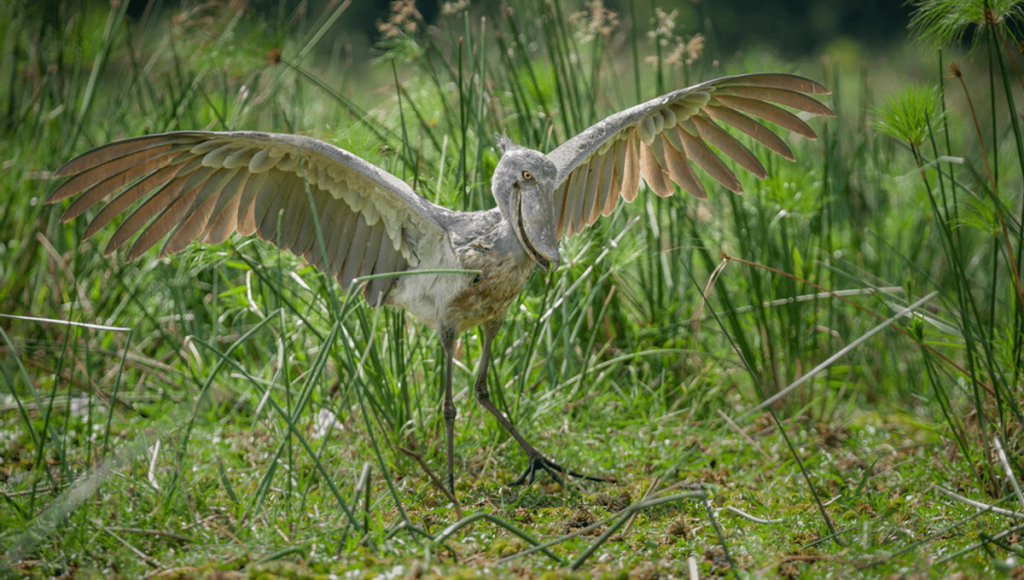
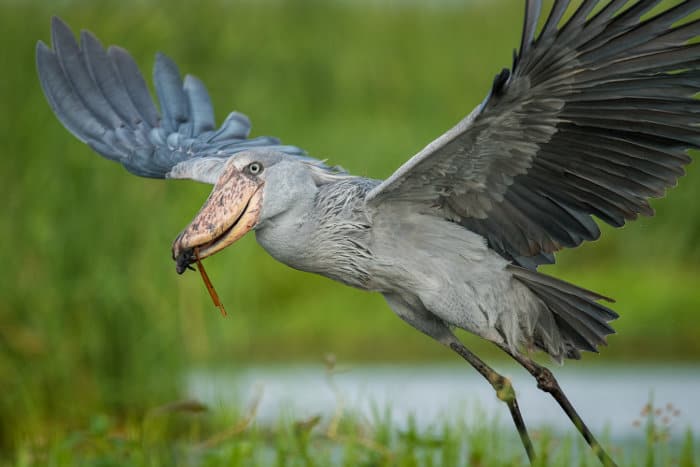
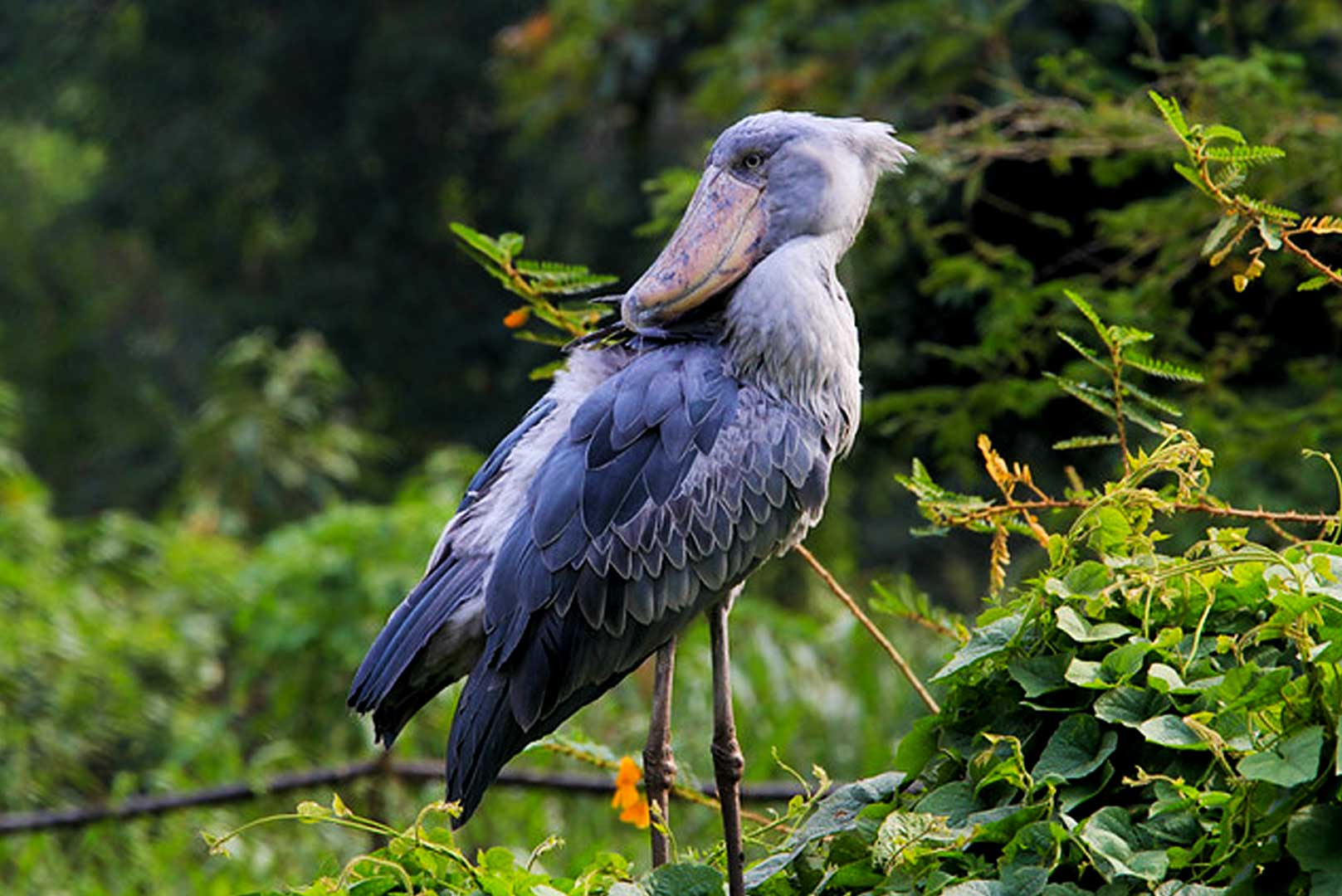
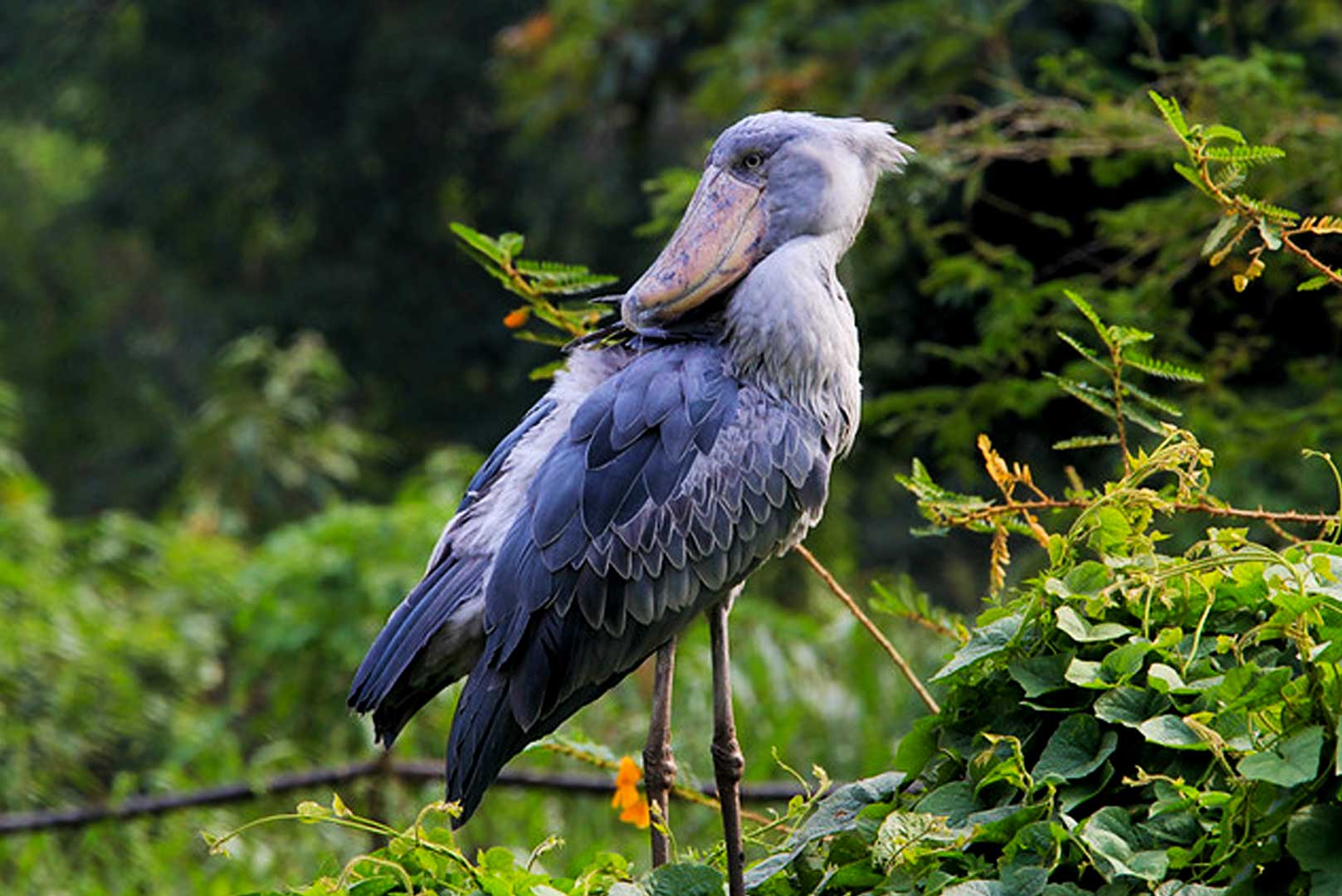
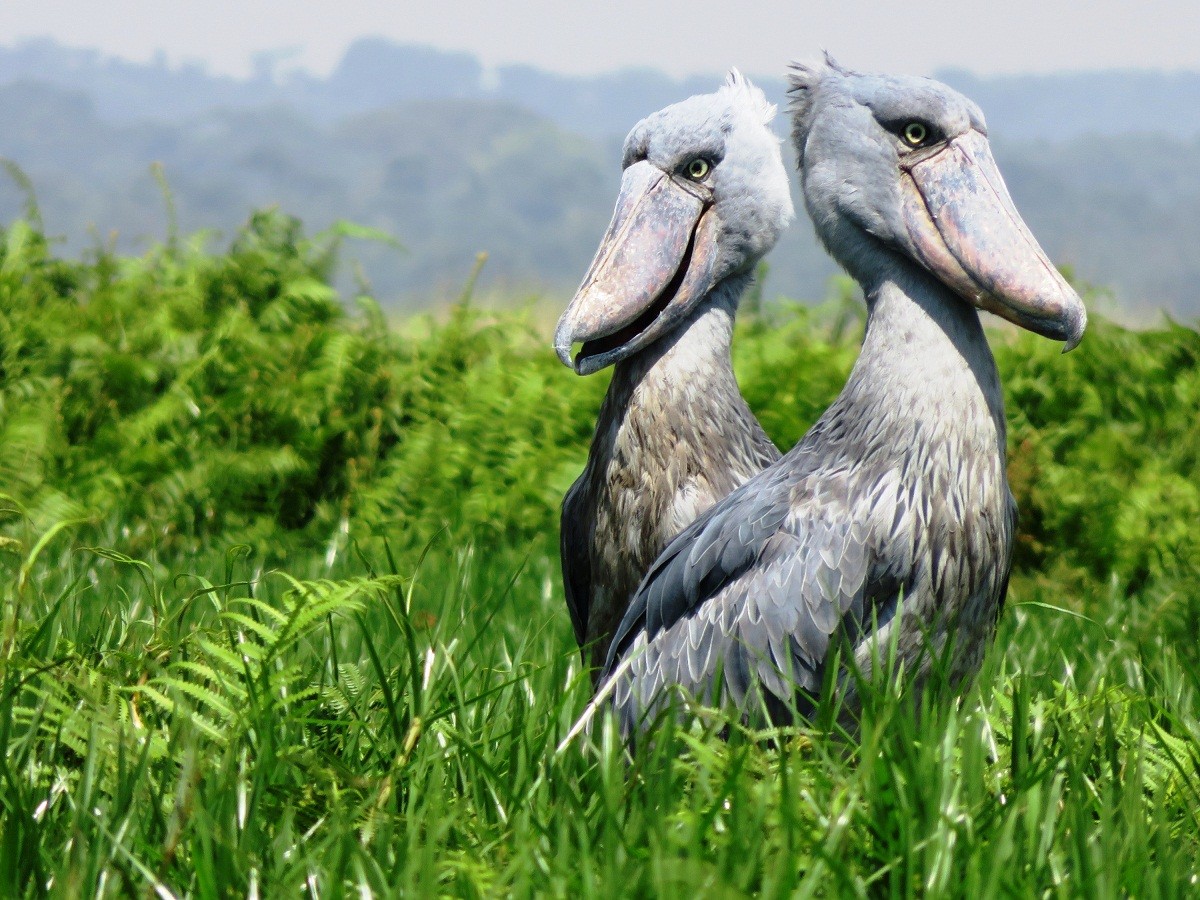



The natural environment of the shoebill is vast areas covered with freshwater swamps and areas located near rivers and lakes. These birds prefer areas with diverse vegetation, in particular areas with papyrus, reeds, and cattail. Occasionally, shoebills feed on rice paddies in Sudan and other flooded plantations. They like the environment of poorly oxygenated waters because it is easier for them to hunt fish that swim just below the surface of the water.
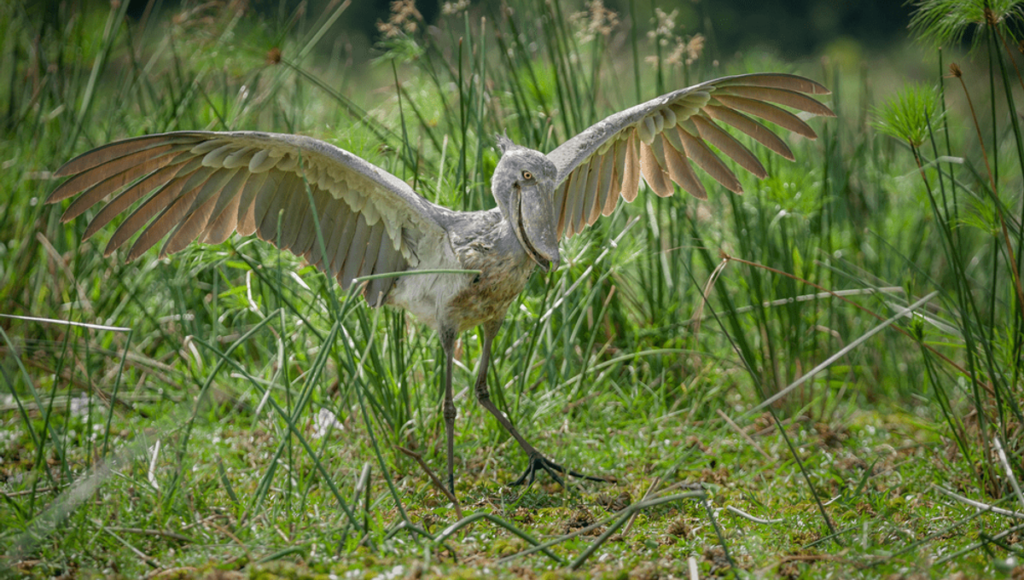
The shoebill is not a migratory bird, it only moves periodically due to the availability of food, and the movement of these birds is also caused by the disturbance of their natural habitats by humans.
Shoebills are sexually dimorphic. Males are larger and have longer, more massive beaks.
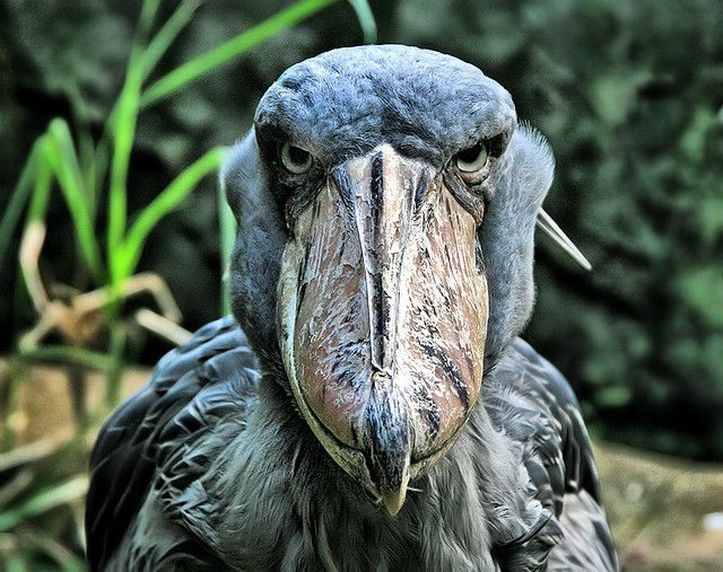
The Shoebill is a large bird, its body length (from tail to beak) between 100 and 140 centimeters, The height of the bird at the withers – is from 110 to 140 centimeters, although specimens are reaching even 150 centimeters. The wingspan is from 230 to 260 centimeters. Weight: from 4 to 7 kilograms, the male weighs 5.5 kilograms on average, and the female weighs 4.9 kilograms.
They lead a solitary lifestyle, forming loose groups only when food is scarce and forced to forage side by side. During the breeding season, they form monogamous pairs, build a nest together, brood their eggs, and take care of their offspring. They lead a nocturnal lifestyle.
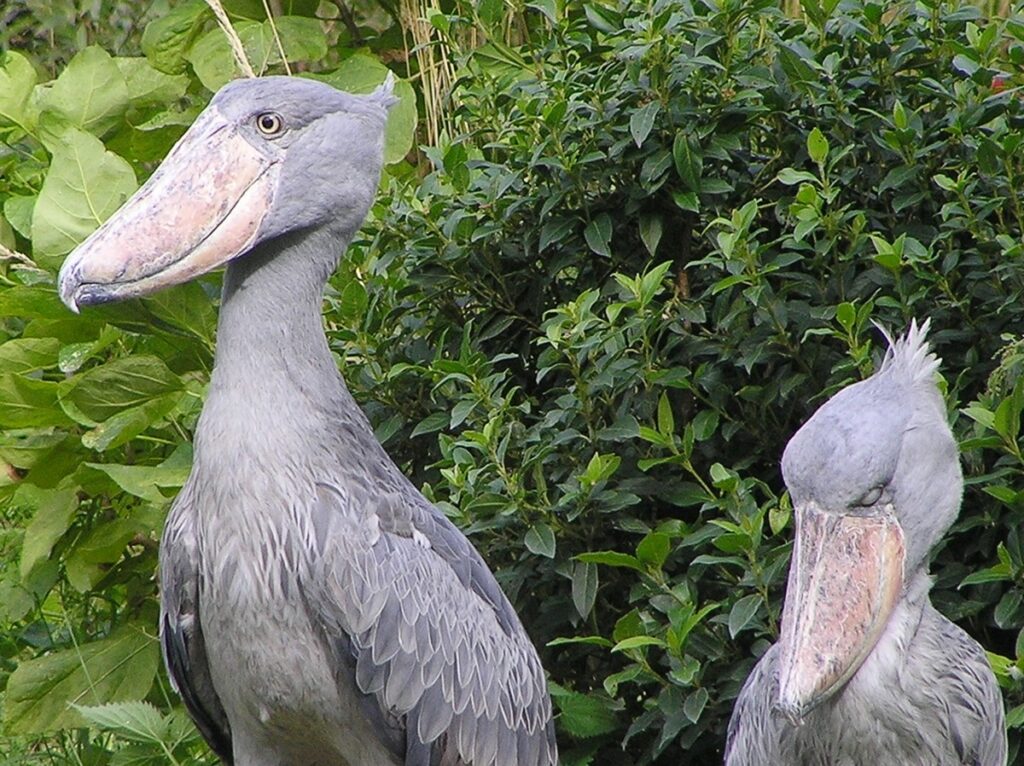
Shoebill is a food specialist.
They hunt only a certain type of animal, which are lungfish, 15 to 50 cm long and weighing around 500 g. This way, these birds avoid competition. Sometimes, when the opportunity arises, they also hunt for frogs, young crocodiles, turtles, small mammals, and mollusks. They will not disdain carrion either.
These birds have a specific hunting strategy;
they know the lake or other bodies of water well, so they know where the fish are at a certain time of the day. The shoebill patiently wades in the water or stands calmly and waits for the fish to swim to it by itself. As the fish approaches, the bird lunges at it, spreading its wings. Its suddenly spread wings stun the fish for a moment, while the shoebill catches it, crushes it with its mighty beak, and swallows it.



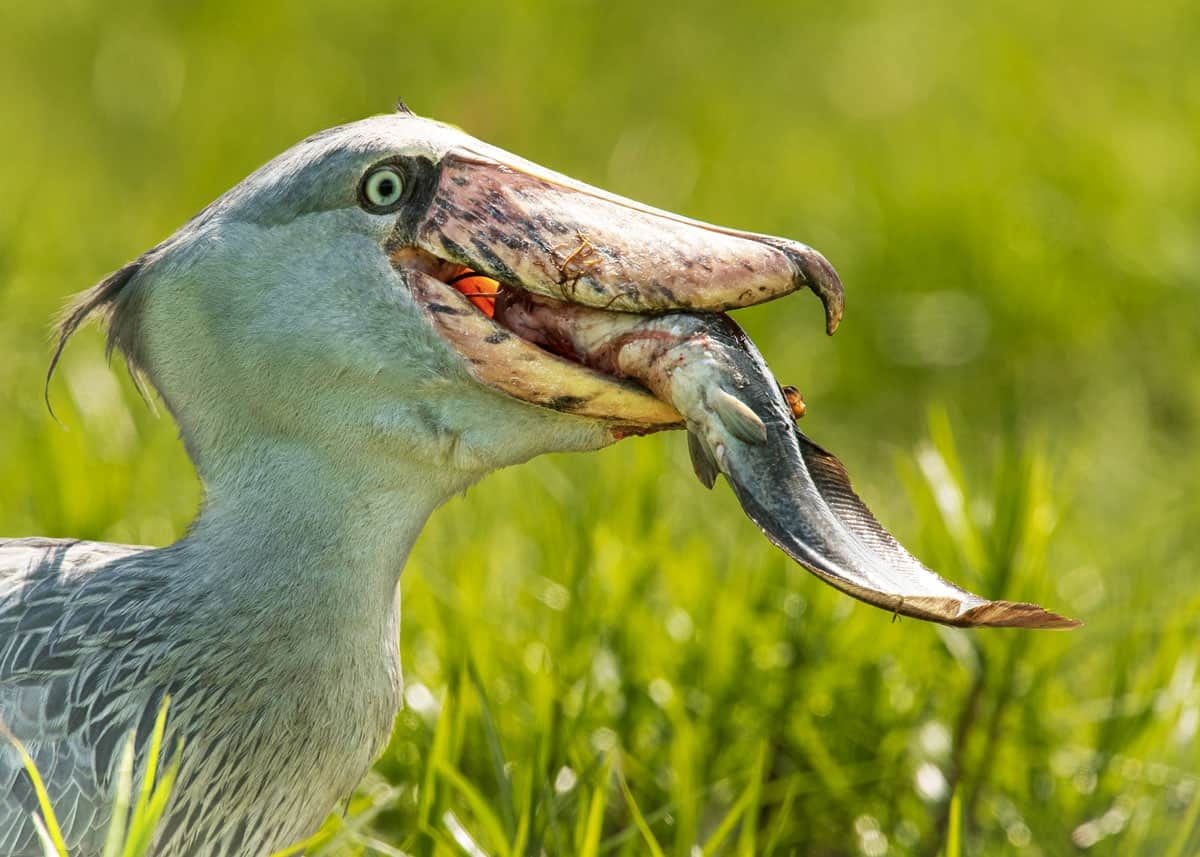
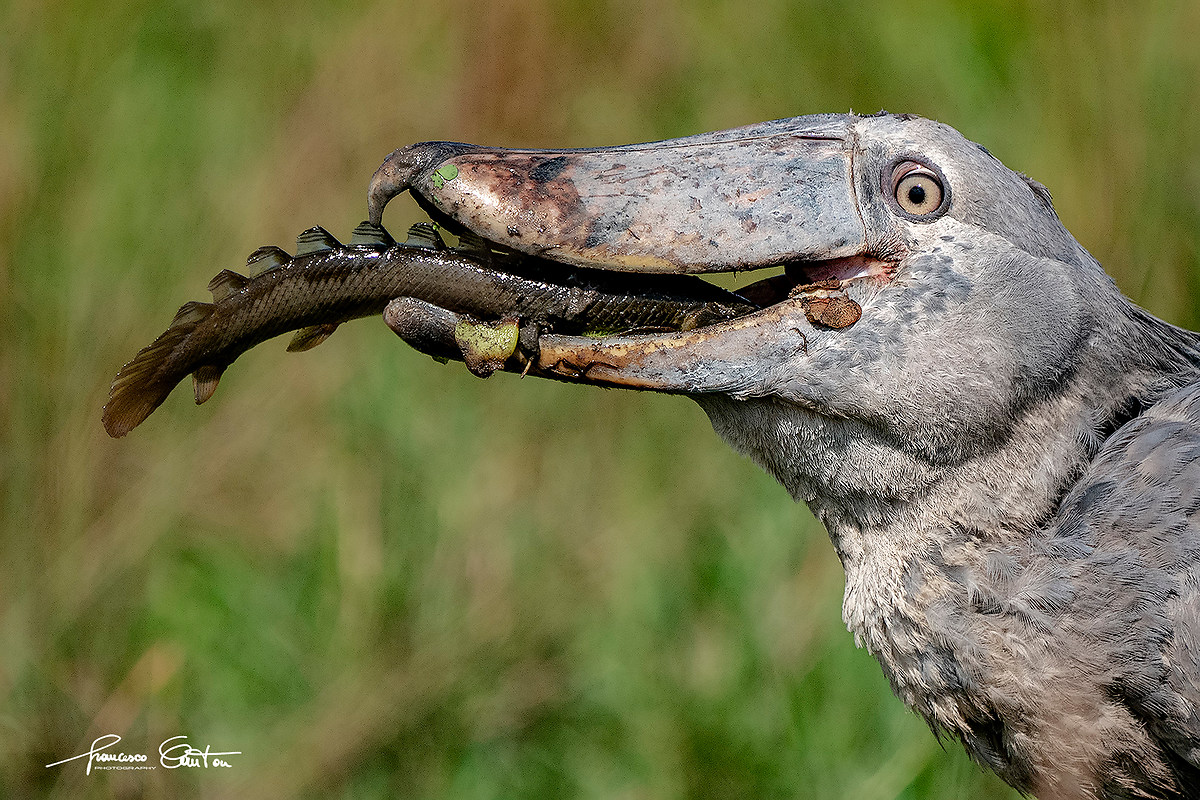
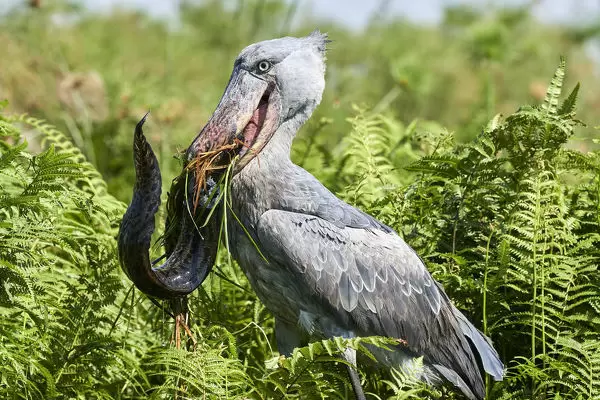
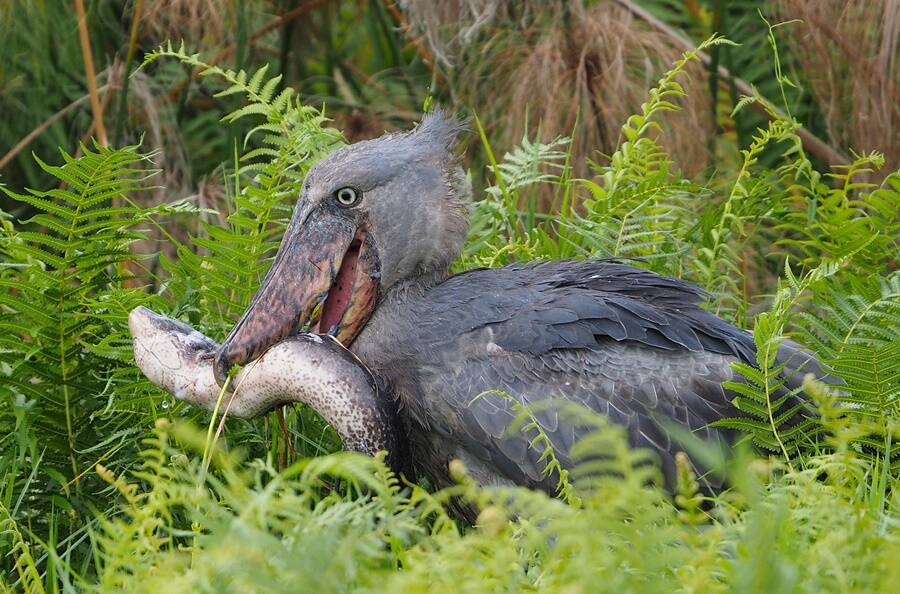
They usually hunt alone, and a greater number of hunting birds can only be observed when the water body dries up, leaving only a small puddle full of trapped fish.
They have the 3rd longest beak in the world, which enables them to hunt extremely large prey, even baby crocodiles. Their beaks can reach up to 24centimeters in length and 20 centimeters (7.4 to 9.4 inches) in width, which helps them hunt for fish or snakes as long as 3.2 feet (1meter) in size.
The razor-sharp edges of its beak, allowing it to decapitate its prey quickly. They are known to often behead their prey, before consuming them whole.
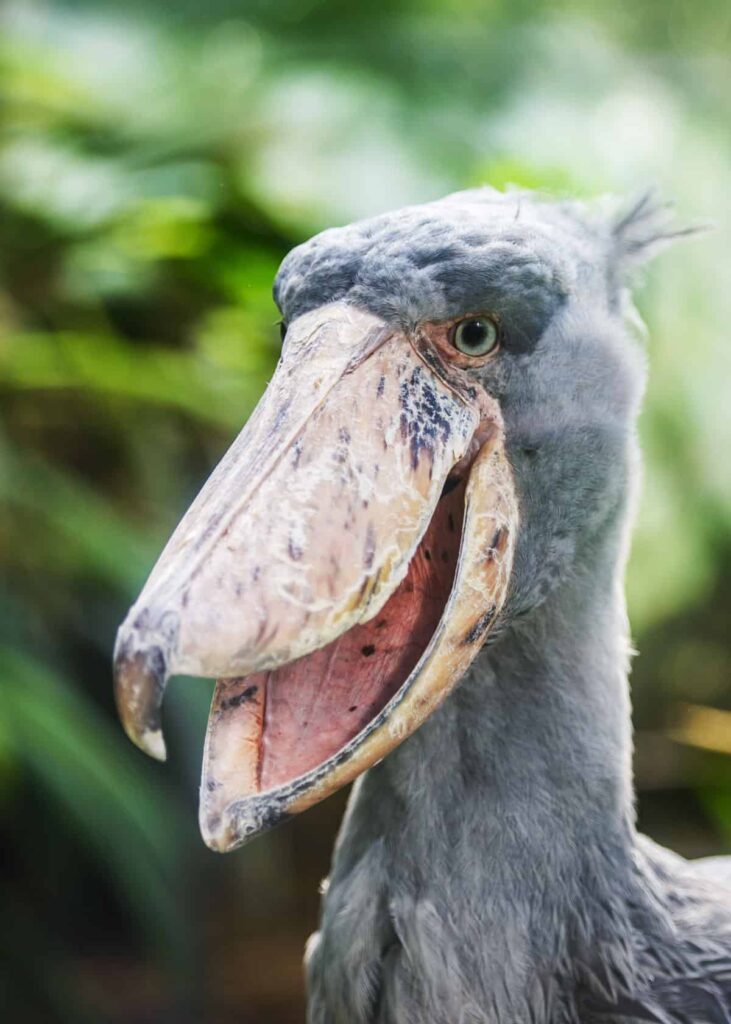
Shoebills primarily feed on fish. Their favorite prey is lungfish. They also eat frogs, water snakes, lizards, and even baby crocodiles. They sometimes eat rats as well.



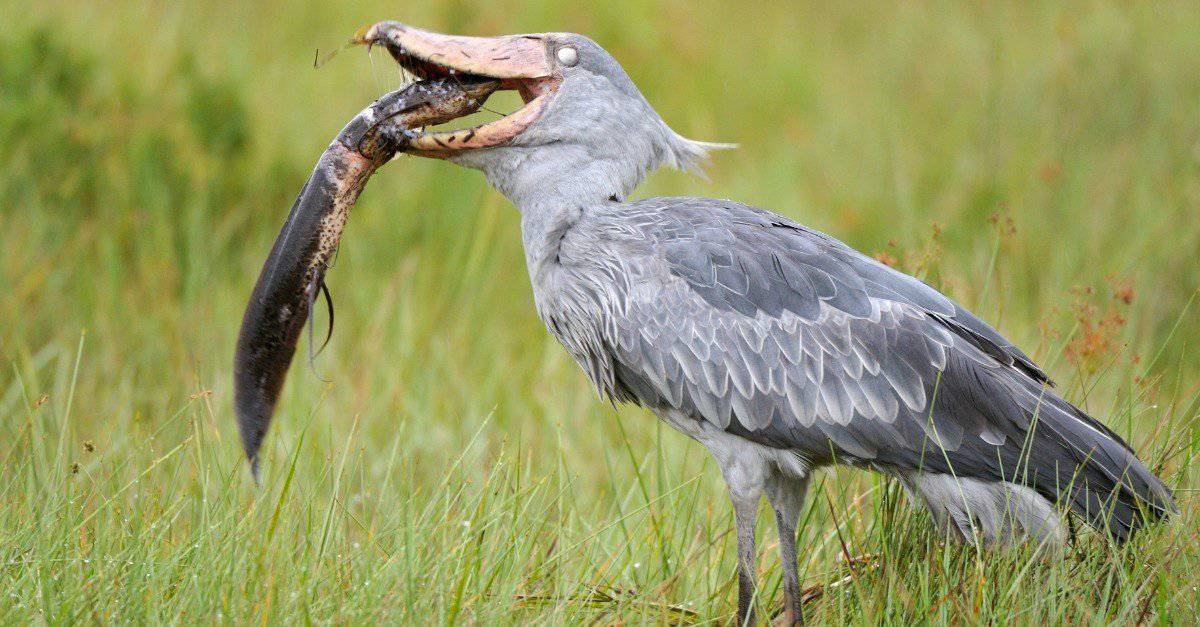

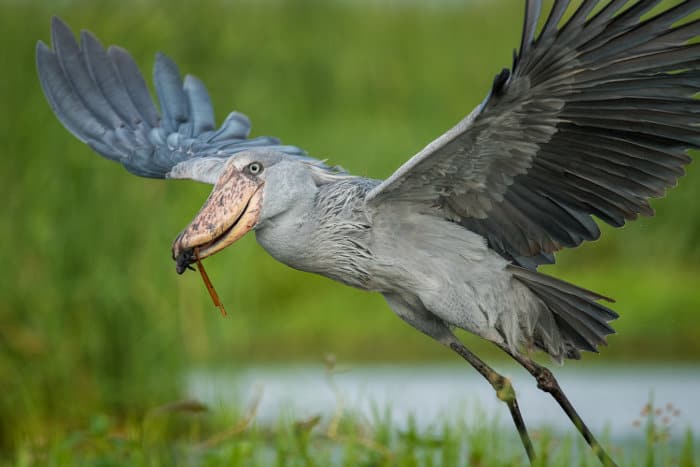


A shoebill can often benefit from the presence of hippos, which disturb fish and bulldoze paths through swamps. The shoebill can take advantage of the disturbed fish in the water and strike.
The shoebill stork does not take no for an answer!
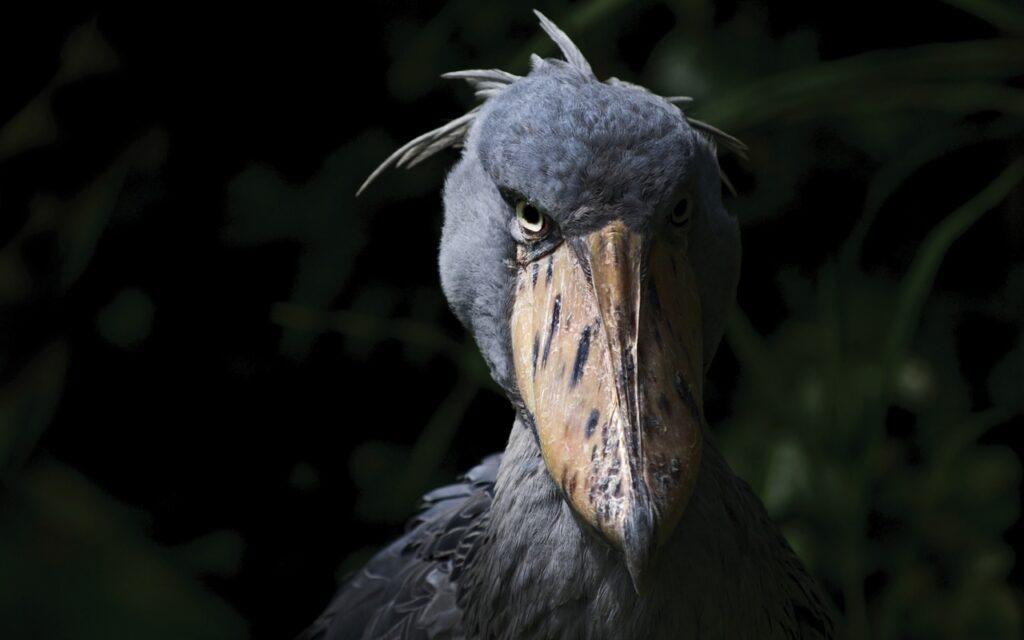
The species is aggressive. They fight off small and large animals alike. If a weak animal comes across their path, the stork will leap from their hiding place to turn it into a meal. If a strong animal makes the stork unhappy for whatever reason, including being in their line of sight, the stork has no problem attacking the creature. Storks have been known to fight Nile crocodiles, other species of storks, and even each other.
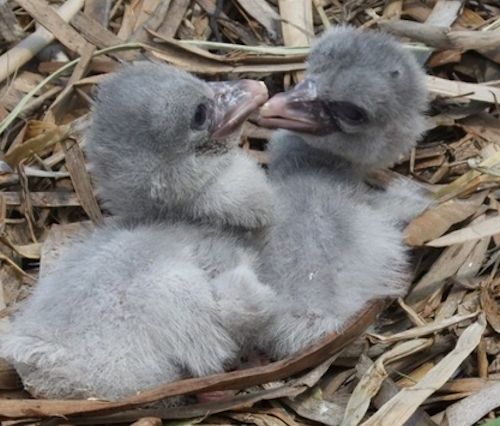
Shoebill nests in the shape of a flat mound.
Usually, it is found on floating vegetation or grass on dry land, in a place inaccessible to predators. The female lays 1 to 2 eggs, and the incubation period is 30 days. After hatching, their parents provide them with food up to 6 times a day. The young are fully covered with feathers only after 60 days, and they acquire the ability to fly about 112 days after hatching. The full breeding period is 140-145 days, only then do the young leave the nest, although they return to it for some time to rest. The young are initially fed with partially digested food, and over time they eat the whole fish.
Shoebill storks are masters of patience.
They will stand in water, large patches of grass, and other hiding places for hours on end. Shoebills eat at night and sit perfectly still, blending in with the darkness around them. They know that if they wait long enough for the right moment, they will find their next meal.
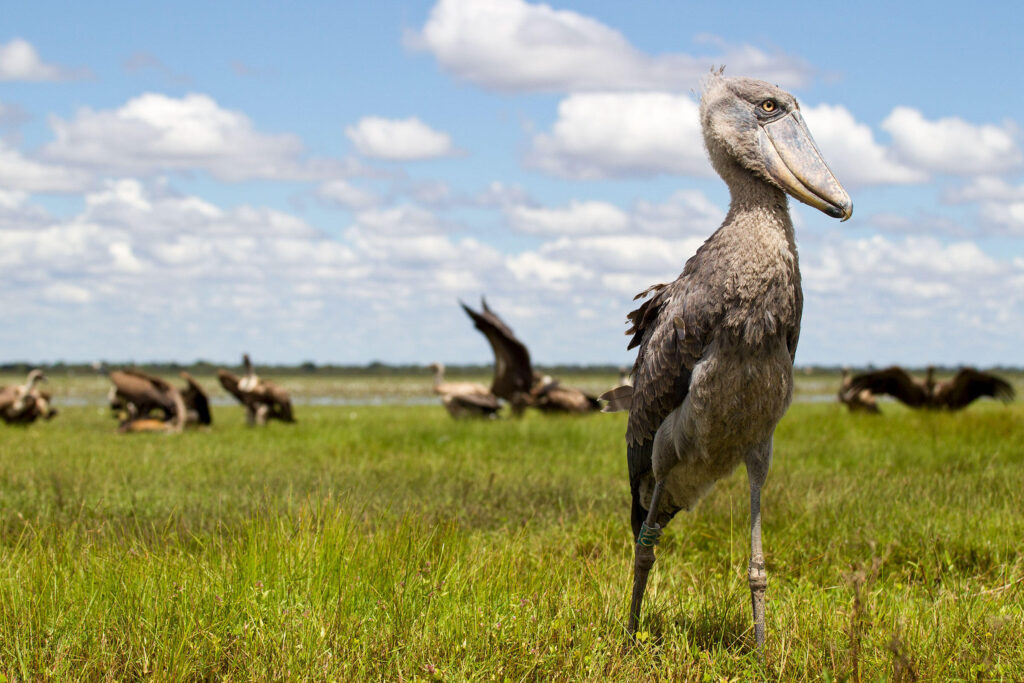
Part of being stealthy and waiting for the right moment is staying silent.
The shoebill stork knows this. That is why it will never make noise when hunting for prey. However, come a mating time, the shoebill will release a loud cry to attract a partner. Their shriek sounds like a machine gun. It is a series of loud, terrifying popping noises. Potential mates love the sound and will come to the noisy shoebill.
The phenomenon of Cainism occurs in shoebills.
It consists in eliminating weaker individuals with stronger siblings to eliminate food competition. When the parents of hatched shoebill chicks move away from the nest in search of food, the stronger one starts attacking their brother, pecking at his plumage and even injuring him. After returning to the nest, the parents keep the stronger specimen in it, the weaker one is removed and has to cope on its own – most often it does not survive.
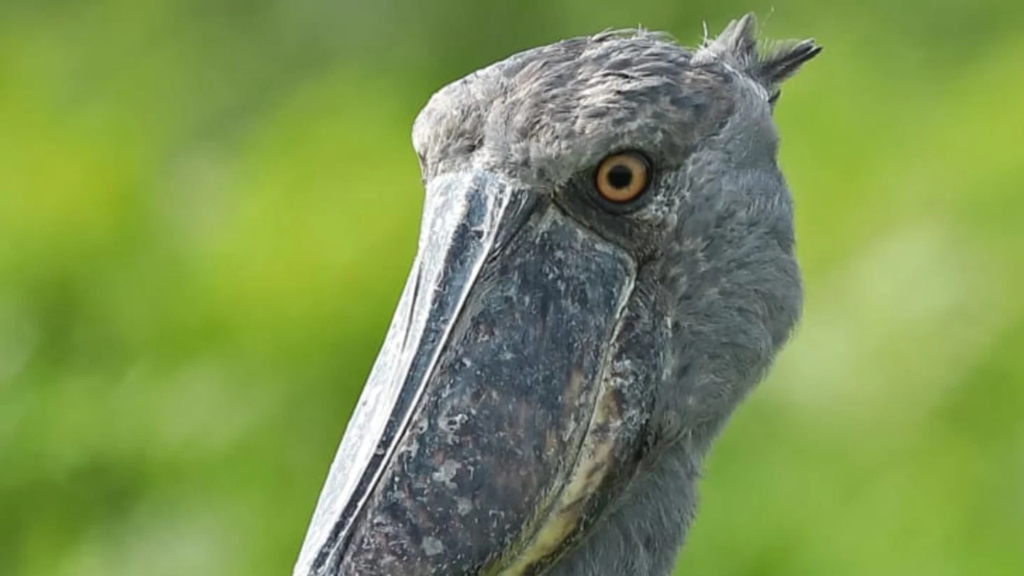
The shoebill’s flapping when flying is one of the slowest of any birds, at a mere, approximately 150 flaps per minute. Only larger stalk species have slower flapping than the shoebill.
Shoebills in general are quiet birds, but sometimes you can hear their characteristic clattering, similar to storks. They clatter when they feel threatened or in greeting the nest. When hunting, the primary senses these birds use are sight and hearing. To increase the field of view, the shoebill keeps its head almost vertical, parallel to the breast, sometimes giving the impression of being standing.
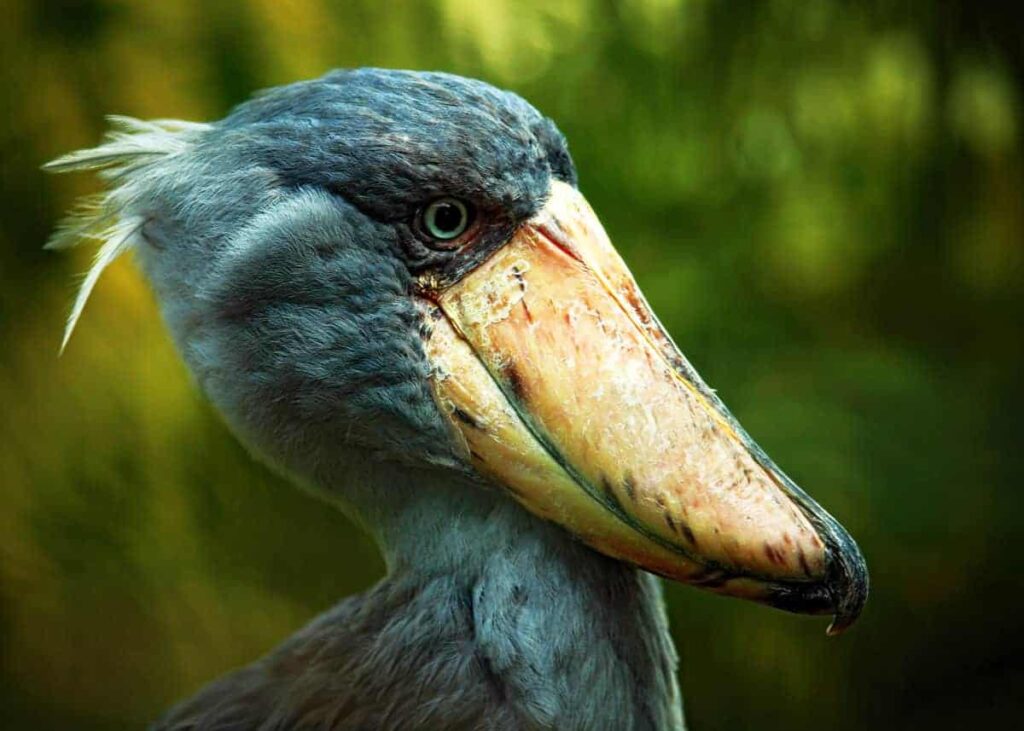
They are an endangered species.
The global population of Shoebill in 2002 was estimated at 5,000-8,000 individuals. Their population is threatened by human activity (over-irrigation, burning grass, cattle grazing, fishing, drainage of swamps, etc.). Moreover, these birds are caught for consumption. Eggs and chicks are either eaten or sold to zoos and collectors.
Shoebill is one of the most expensive birds purchased for zoos.
The price of one individual range from $ 10,000 to $ 20,000. Unfortunately, these birds do not reproduce in captivity.
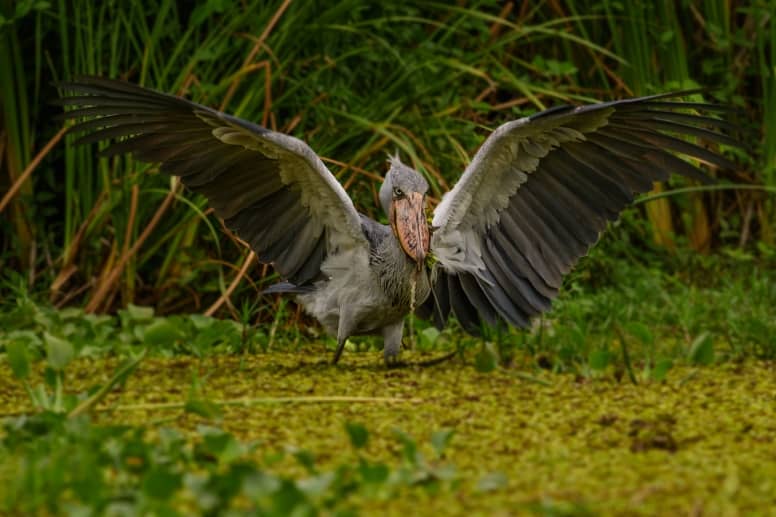
The shoebill stork can live for up to 35 years!
That is a good age for an animal – especially a bird. The average dog will live to be 15 years old. Shoebill storks can live long enough to see seven generations.
***BONUS***
Check out the video for todays post:


